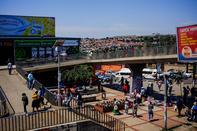Climate change and continued rapid urbanisation will make the management of conditions such as HIV/AIDS, as well as malnutrition and diarrhoeal disease, more difficult.

In terms of building urban communities that are more resilient to climate change – both within and outside the food security context – city planners and managers need to design and build well-serviced neighbourhoods: water and electricity coming in, waste and effluent going out, and stormwater systems that do not become overloaded during flooding events.
Just as the city block needs to be on the grid and properly serviced, so individual homes need to be designed and built in a way that is conducive to healthy living. Homes need to be insulated and protected against extreme weather events such as heat-waves and flooding. Heatwaves are most taxing on the aged, young children and those with respiratory and cardiac problems.
Keeping people on the grid – with electricity to cool and cook food – will be key to mitigating the worst impacts of heatwaves on food safety. This should coincide with more education on food safety and hygiene, particularly for people already in a state of compromised health, such as the HIV-positive.
Tackling climate change and food insecurity in the city, requires: pro-poor urban design and planning; physical infrastructure development; income support and social welfare; local economic development; urban food production; looking at cross-scale linkages; and putting the right regulatory frameworks in place.
By Leonie Joubert